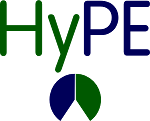 |
Hybrid Query Processing Engine for Coprocessing in Database Systems
HyPE
|
 |
Hybrid Query Processing Engine for Coprocessing in Database Systems
HyPE
|
HyPE uses CMake as a cross-platform build system. Generally, building HyPE is similar on all platforms but we will nevertheless highlight some platform-specifics on this page.
There might also be precompiled binaries for your platform and toolchain.
Note that C++ libraries for one platform (e.g. Windows) built with different toolchains or merely different toolchain versions are generally not interchangeable.
HyPE depends on the following third-party libraries and tools:
HyPE has been tested with the following compilers/build-environments on Linux:
To install all prerequisites on Ubuntu Linux, install the following packages:
sudo apt-get install gcc g++ make cmake doxygen graphviz libboost-all-dev build-essential gnuplot-x11 ffmpeg libloki-dev libloki*
Now you can configure the HyPE package. We advise you to do a CMake out-of-source-tree build, for instance using the following commands from a shell:
cd hype-library mkdir build cd build cmake ../
If you encounter any errors during configuration, or want to tweak HyPE's build system you may want to run `ccmake` to manipulate CMake's cache and re-generate the build-system. The appropriate options are documented.
To build HyPE, use:
make
To build and run the test suite, type:
make check
To build the documentation, type:
make hype-doc
To install HyPE, type (as root):
make install
HyPE was tested with Windows using the following toolchains:
Naturally, other toolchains like MinGW-64 and newer versions of Visual Studio might work as well.
In any case, if you would like to build HyPE's documentation, install Doxygen via its Windows installer. If you let the installer add Doxygen to `PATH`, the build system will locate it automatically.
You must also install CMake, presumably via its Windows installer. Let the installer add CMake to `PATH` as well.
To install HyPE using the MinGW toolchain, first build MinGW versions of the dependant libraries. They do not necessarily have to be installed into the MinGW/MSYS path hierarchy.
Boost must be built for the MinGW toolchain, Visual Studio builds will not work. If you cannot find an appropriate binary, build the binaries from a MinGW command shell (cmd.exe):
cd boost_1_53_0 boostrap mingw bjam toolset=gcc
The Loki library must also be built for the MinGW toolchain. At first you must remove Loki's `src/LevelMutex.cpp`, since it is broken on MinGW and not required by HyPE. From a MinGW shell (MSYS Bash), type:
cd loki-0.1.7/
mingw32-make build-static build-shared OS=Windows
Now you are ready to build HyPE. From a MSYS Shell, type:
cd hype-library mkdir build cd build cmake-gui ../
Choose "MSYS Makefiles" as the build system to generate and click _Configure_ to configure the HyPE package. There will be errors. In the CMake cache
Now _Configure_ again - Boost should be properly configured now but not the Loki library. So in the cache (advanced), set
HyPE should now Configure properly and you can click Generate.
From a MSYS Shell you may now build HyPE just like you would on Linux:
cd hype-library/build make
It may also be installed into the MinGW/MSYS paths.
Note: In order to run the test suite, copy all necessary DLLs to `hype-library/build/examples/unitests/`.
To install HyPE using the Visual Studio C++ toolchain, first build MSVC versions of the dependant libraries.
Boost must be built for the MSVC toolchain, MinGW builds will not work. If you cannot find an appropriate binary, build the sources from Windows command shell (cmd.exe):
cd boost_1_53_0 boostrap bjam
The Loki library must also be built for the MSVC toolchain. From a Windows shell (cmd.exe) using Visual Studio C++ 2010, type:
cd loki-0.1.7/
set VS80COMNTOOLS=%VS100COMNTOOLS%
make.msvc.bat
Now you are ready to build HyPE. First generate the Visual Studio project files using CMake. To do so, start CMake GUI and select the HyPE source directory. You may select a different build directory for out-of-source-tree builds. Click _Configure_ to configure the HyPE package. There will be errors. In the CMake cache
Now _Configure_ again - Boost should be properly configured now but not the Loki library. So in the cache (advanced), set
HyPE should now Configure properly and you can click Generate.
In Visual Studio, you can now open the generated solution file `HyPE.sln` (located in the build directory) and build the entire solution or a specific target.
Note: In order to run the test suite, copy all necessary DLLs to `hype-library/build/examples/unitests/` (or whatever your build directory is).
Note also, that when performing a _Debug_ build, all dependent libraries must be debug versions as well. Debug versions of Boost are automatically selected by the build system, but Loki library Debug versions must be manually built and selected in the CMake cache.